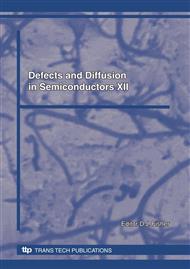p.1
p.7
p.21
p.31
p.39
p.55
p.63
p.85
p.99
Artificial Aging Behavior of 6063 Alloy Studied Using Vickers Hardness and Positron Annihilation Lifetime Techniques
Abstract:
Many aluminum-based alloys are strengthened by a heat treatment process known as age hardening. The aim of this work was to produce a high-strength 6xxx series aluminum alloy by adjusting the processing conditions, namely solutionizing and artificial aging. It consists of heating the alloy to a temperature at which the soluble constituents will form an homogeneous mass by solid diffusion, holding the mass at that temperature until diffusion takes place, then quenching the alloy rapidly to retain the homogeneous condition. In the quenched condition, heat-treated alloys are supersaturated solid solutions that are comparatively soft and workable, and unstable; depending upon the composition. After solution treatment and quenching, hardening is achieved either at room temperature (natural aging) or by precipitation heat treatment at a suitable temperature (artificial aging). Precipitation heat treatments are generally low-temperature long-term processes. Temperatures range from 115 to 190°C and times vary from 5 to 48 h. Choice of time-temperature cycles for precipitation heat treatment should receive careful consideration. The objective is to select the cycle that produces the optimum precipitate size and distribution pattern. The mechanical characterization of heat-treatable 6xxx (Al-Mg-Si-Cu based) 6063 wrought aluminum alloys was studied. Their effects were investigated in terms of the microstructure, using positron annihilation lifetime techniques and mechanical properties monitoring via Vickers hardness measurements. The hardness is the resistance of a material to plastic deformation, which gives it the ability to resist deformation when a load is applied. The greater the hardness of the material, the greater the resistance it has to deformation. The hardness of 6063 alloy has its maximum value (58) when aged for 8 hours at 175oC after quenching from 520oC; which is the solution temperature of this alloy. The hardness conformed to the literature. We also test the aging ability of the 1xxx aluminum alloy: 1050.
Info:
Periodical:
Pages:
31-38
Citation:
Online since:
July 2010
Price:
Сopyright:
© 2010 Trans Tech Publications Ltd. All Rights Reserved
Share:
Citation:


